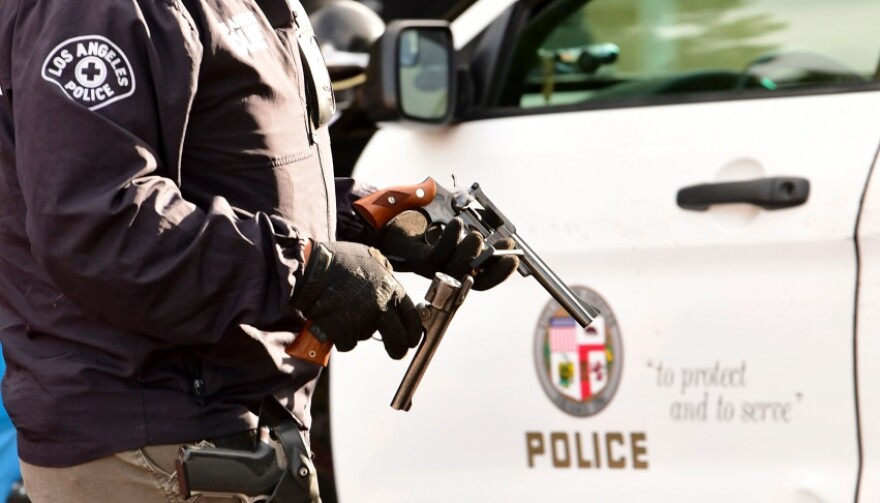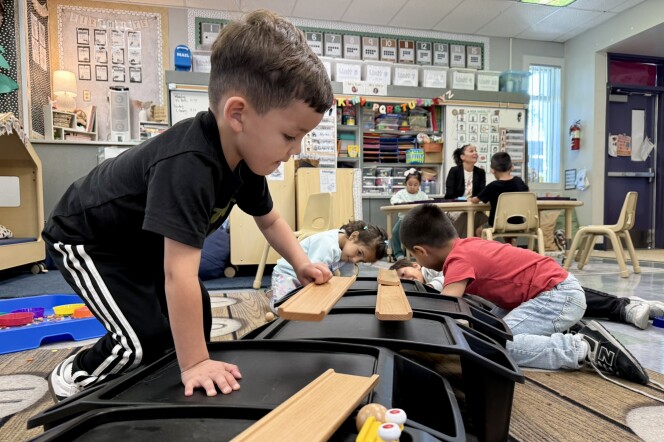With our free press under threat and federal funding for public media gone, your support matters more than ever. Help keep the LAist newsroom strong, become a monthly member or increase your support today.
In South LA, Gang Intervention Workers Are Trying To Slow A Dramatic Spike In Gun Violence -- And They're Asking For Help

The Los Angeles Police Department is calling attention to a dramatic spike in gun violence in South L.A., where 10 people were killed in the first half of January -- more than double the rate of last year. During the same time, 59 people were shot in South L.A., compared to only seven in 2020.
The startling numbers continue a trend of increased shootings and homicides across the city last year, reflecting a nationwide uptick in violent crime during the COVID-19 pandemic.
The LAPD blames worsening gang conflicts and more guns on the street for fueling the shootings, the worst spate of violence in more than a decade.
The problem is complex, involving long-standing gang rivalries, new battles flaring up, and even inter-generational conflict within the same gang, said Reynaldo Reaser, executive director of Reclaiming America's Communities Through Empowerment (R.A.C.E.). Like many who do this sort of violence prevention work, Reaser is a former gang member with close ties to his community, giving him what's known as a "license to operate" in neighborhoods where others would have a hard time making headway.
"There's a mixture: You've got old wars that have been going on for a long time, and then you have new wars between neighborhoods that have never beefed before," Reaser said. "And the older generation is trying to quell the violence, but the younger generation wants to do what they want to do."
The economic and emotional stresses of the pandemic, distrust between the community and law enforcement in the wake of police shootings, social media and drugs -- especially methamphetamine -- are all contributing factors that gang intervention workers cited when talking about the heightened tensions.
"The United States is reckoning with its history of racism in the middle of a 100-year pandemic, which is causing financial deprivation and anxiety," said Fernando Rejón, executive director of the Urban Peace Institute. "We're seeing that frustration manifest at the street level."

Rejón's group is part of a coalition of gang intervention organizations pushing the city for more funding to hire and train workers, as well as provide them with personal protective equipment (PPE) and hazard pay to reflect their frontline status during the pandemic.
There are approximately 120 intervention workers active on a given day in Los Angeles, according to the coalition. Their goal is to increase that number to 500 trained specialists and 250 "peace ambassadors," or community leaders who can assist with conflict mediation and violence prevention.
"While the city has been asking gang interventionists to step up, gang intervention has been diluted over the years," Rejón said. "And now [intervention workers] are burnt out from multiple crises. There's not enough of them and they're underpaid."
The coalition's request for $54 million would also expand the city's office of Gang Reduction and Youth Development (GRYD), which provides infrastructure, coordination and support for community-based violence prevention work in South L.A.
Skipp Townsend, a community interventionist and founder of the Los Angeles-based non-profit Second Call, said he's seeing young people spending more time online because of the coronavirus, getting caught up in rivalries and tough talk splashed across social media posts.
"They don't have the activities that they normally have, and they look for something to do," Townsend said.
"Back in the day, people had to actually get out of their car and write on the walls, and somebody had to see it and, and be offended by it," he said. "Now social media is a platform to argue, or make a name for themselves chasing clout."
"It's ruining the peace that we've had for over 10 years," Townsend added.
It's a pressure-cooker atmosphere. But typical strategies to defuse conflict -- such as face-to-face peace talks, sports programs, prayer vigils and community marches -- have become difficult or impossible because of the coronavirus, which is decimating Black and Brown communities.
"You're talking about gang members and how to create peace," Reaser said. "A lot of guys don't know how to use Zoom and other technology, or they don't want to."
The shootings are not exclusively gang-related, City Councilmember Marqueece Harris-Dawson pointed out.
"There are people who may have had ongoing disputes, where their family and friends likely knew about those disputes," he said. "And now is not a time to let that stuff fester."
Law enforcement voices argue that recent criminal justice reforms passed by voters and decisions by elected officials are exacerbating the bloodshed.
"My deputies have arrested the same person for multiple crimes in the same day," said Duane Allen, Los Angeles County Sheriff's Captain with the South L.A. Bureau. During an online town hall on Tuesday, he pointed to policies by the state of California and Los Angeles County D.A.'s office to eliminate cash bail and lower the prison population because of the threat of COVID-19.
"[We are] arresting bad people. But a large percentage of those same folks are probably out of the station within four hours," Allen said. "There's not as much accountability."
Rejón disagreed, calling anecdotes from law enforcement "fear-based rhetoric."
The solution is not keeping more people behind bars, he said, but "divesting from systems that have been perpetuating racial injustice, and building communities' capacity to take control of safety and health in their neighborhoods."
"You need to fund peacemakers and fund public health and safety infrastructure in order to help support folks that have been released from prison, helping to reintegrate them into the community, help to close the community-to-prison pipeline," Rejón added.

"It is not a law enforcement problem, it is a public safety problem," said Jorja Leap, a gang expert and adjunct professor of social welfare at UCLA's Luskin School of Public Affairs. She recently completed an analysis of LAPD's Community Safety Partnership program at three public housing complexes in Watts and one in Boyle Heights.
Leap highlighted the jurisdictional challenges of violence intervention in South L.A., where one street might be policed by the Sheriff's Department, while the next block over falls under the purview of the LAPD. The Urban Peace Institute and others have called for a regional strategy to better coordinate resources between city and county.
"This is multifaceted. The old ways of doing things are not going to work, and it's never going to be solved by simply putting cops [in hotspots]," Leap said. "If anything, sometimes that heightens the issues."
Harris-Dawson said no single solution will turn things around.
"We're trying to get the community engaged, so that folks can look out for when there are disputes, and look out for potential problems before they happen," Harris-Dawson said.
That may mean working with the LAPD, where appropriate, he added, but also with faith leaders, creating tighter social connections, and interfacing with community-based gang intervention specialists such as Reaser and Townsend.
"We need to hear from the mayor and we need to hear from all the institutions in the city that were so concerned when windows were being broken in one part of town," Harris-Dawson said. "We need to hear people stand up and step up to help deal with the amounts of homicides that we're seeing because we know these things may start in South L.A., but they grow throughout the city"
Our news is free on LAist. To make sure you get our coverage: Sign up for our daily newsletters. To support our non-profit public service journalism: Donate Now.







